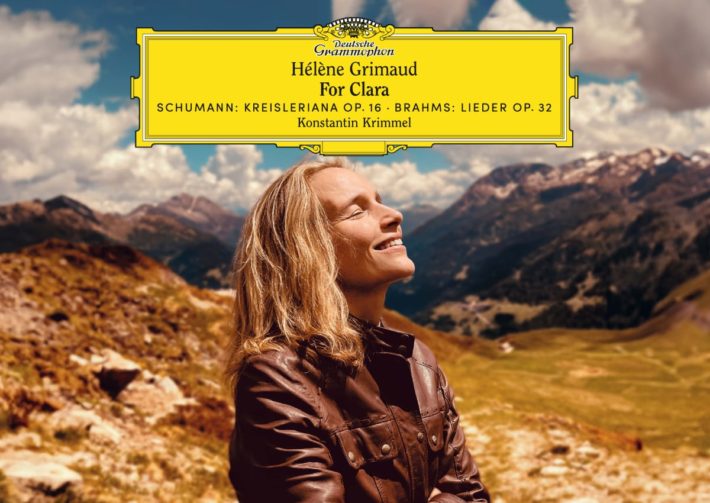There were moments in this new album by Hélène Grimaud where I was distinctly reminded of great Romantic pianists from the past (Horowitz comes to mind)—especially the piano technique in slow moments where the two hands are never played together and with the aid of plenty of sustaining pedal. This style is somewhat rare these days in the competition standards, where all is “transparent”, “responsible”, “period aware” etc. This style of old will not surprise followers of Grimaud’s sizable discography; she has recorded most works here before. Schumann’s Kreisleriana appeared on a disc for the Denon Label in the late 1980s and Brahms’ Op. 117 Intermezzi have a counterpart from the mid 1990s from a fabulous performance of the late piano pieces for Teldec.
That Grimaud calls Schumann “the most literary of composers” is not an overstatement. The Op. 2 Papillons, Op. 9 Carnaval, and Op. 16 Kreisleriana all have deep ties to the writings of Jean Paul and E.T.A. Hoffmann—and Schumann’s own divergent alter egos, Florestan and Eusebius. The greatest pianistic challenge of these sets is to bring to life the diametrically opposed entities, even in the shortest works. The opening number of the Op. 16 (track 1) is a perfect example at under 3 minutes: while the presence of a sprawling, passionate D minor and calmer B-flat major forces are undeniably present, they could be even more multifaceted. In this regard, Radu Lupu (Decca) creates greater variation between and within characters, heightening their dynamism and unpredictability.
Sehr innig (track 2) is, however, successful in summoning an introspective and rather stubborn Eusebius as well as a bold yet perky Florestan (2’41”). Sehr Langsam (track 4), devoted to just one alter ego, gives us a chance to listen to how the pianist handles the character development. A relaxed tempo, lithe legatos, and both nuanced and luscious tones paint Eusebius as moody yet thoughtful. Sehr rasch (track 7), on the other hand, gives us extroversion (or madness?) in full glory: Grimaud’s dry articulation accentuates Schumann’s purposefully unbalanced rhythms and textures. Florestan, it seems, is not without his eccentricities and a humorous clumsiness.
Related Classical Music Reviews
- Review: “The Messenger” – Hélène Grimaud Plays Mozart and Silvestrov
- Review: Brahms – Piano Concerto No. 1, Four Ballads – Lars Vogt
- Review: An Invitation at the Schumanns’ – Trio Dichter
Brahms’ Op. 117 Intermezzi defy their small form. Each is a profound personal exploration: contemplative, somber, at times persuasively dramatic—but above all, deeply expressive. It is in the presentation of these sentiments where Grimaud does her finest work. The breadth of her emotional colors is wide and responsive, especially to Brahms’s rich harmonic colors.
The composer prefaced the E-flat Intermezzo (track 9) with words from a Scottish Ballad and indeed, we can hear undertones of a folk element in the lovely melodies. Grimaud’s familiarity and comfort with the piece is abundantly evident in how she manages its contrapuntal complexity. Brahms’s lines are often deeply interwoven, yet we don’t get mired down, as she makes clear the path of each. The solemn No. 3 (track 11) is easily the most enigmatic: the intricate web of melodies heard in the prior works feels abruptly replaced with a monophonic and tonally ambiguous opening. Where we hear the growth from her earlier recording is in the treatment of these seemingly “simple” moments. This current version goes beyond preserving lyricism and creates more nuance. For instance, the calmness of the theme is offset by a lurking unease; the minor sections, though velvety and mellow, also have a pervading sense of austerity and ominousness.
Comparing both the Kreisleriana and Op.117 to Grimaud’s previous versions, it’s clear this new attempt is generally more open and with a larger projection (especially in the Schumann). These new versions are slightly slower but they don’t feel like it. The pianist’s general approach to these works hasn’t changed significantly over the years, but there is the advantage of a performance that exudes a sense of liberation that comes from her years of familiarity with these compositions–not to mention a better recording and instrument.
The disc also includes a performance of Brahms’ Op. 32 Lieder und Gesänge with baritone Konstantin Krimmel. I had earlier reviewed Krimmel’s performance of Schubert’s Die Schöne Müllerin with Daniel Heide and am happy to say that his performance here is certainly a step up. Not only does his voice stand up to and pair well with Grimaud’s robust sound, but his approach to these songs and Brahms’ writing in general feels much more organic.
The sound engineering here is very good: well-placed mics capture equally adeptly Grimaud’s subtlest and most orchestral playing. I found the piano nicely regulated (a rare thing): the bass, while deep, does not overpower. The treble retains smoothness even in the highest registers.
These fine performances and thoughtful curation of works in both a solo and collaborative context only seek to cement Grimaud as a fine interpreter of these two composers. A most enjoyable listen.

For Clara – Schumann: Kreisleriana Op. 16 & Brahms: Lieder Op. 32
Hélène Grimaud, Piano
Deutsche Grammophon, CD 4864202
Recommended Comparisons
Horowitz | Lupu | Grimaud – Denon | Grimaud – Teldec
Read more classical music reviews or visit The Classic Review Amazon store
Follow Us and Comment:
[wd_hustle id=”HustlePostEmbed” type=”embedded”]











